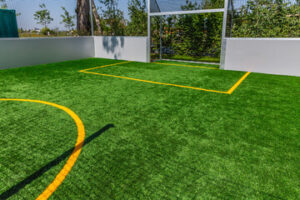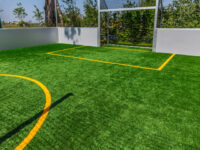Artificial Turf Is a Cost-Effective Solution For Golf Course Builders
Golfers around the world are discovering the benefits of artificial turf. Unlike natural grass, which requires expensive and time-consuming maintenance, synthetic turf is easy to maintain and requires very little water.
From backyard putting greens to 18-hole courses, synthetic grass provides an ideal surface for practice and play. It also reduces the environmental impact of traditional course maintenance methods. Click https://vantaoutdoors.com/sod-installation/ to learn more.

Artificial turf is a cost-effective solution for golf course builders because it requires less maintenance than traditional grass greens. Turf is made from synthetic fibers that do not need water or fertilizers to grow, reducing construction and operational costs. Additionally, it does not need regular mowing, reducing labor costs.
In addition, the use of synthetic turf significantly reduces the environmental impact of golf courses. Using chemicals such as herbicides and pesticides to maintain natural grass greens harms the environment, and artificial turf eliminates this problem. It also prevents the runoff of these chemicals into water sources, preserving the quality of local waters.
Another major benefit of using artificial turf on a golf course is that it can be installed in areas where space is at a premium. That is especially useful for public courses in cities with limited land for golfing or when a club wishes to create an updated look without extensive renovations.
Putting greens are often the first to switch from natural grass to artificial turf, and they provide an excellent example of the improved playability that comes with these systems. When used correctly, a putting green can mimic the bounce and roll of natural grass with minimal effort. That gives golfers a better shot at consistent performance and allows them to practice on otherwise unavailable surfaces due to weather conditions.
Using synthetic greens can also reduce golfing injuries because these systems are designed to absorb the shock of impact and cushion the impact of players’ swings. That is a much-needed improvement over natural grass, often leading to aches and pains in the arms, wrists, shoulders, and ankles.
Artificial greens can also improve the overall golf experience, as they are more stable and have a more realistic ball speed than natural grass. That can help golfers hit the ball longer and more accurately, making the game more enjoyable for everyone involved. In addition, the lack of weeds and other grasses on an artificial turf golf course can increase playability, as finding your ball after each putt will be easier.
Golf is a relaxing and social sport but requires dedication and focus. Practicing is essential to becoming a good golfer, whether at an exclusive club or even in your backyard. Artificial turf has become a popular choice for practice putting greens for its numerous benefits and improved playability.
Unlike natural grass, a synthetic golf course will maintain a consistent and high-quality playing surface all year round, regardless of weather conditions. That ensures that golfers of all skill levels can enjoy the game at a comfortable level without having to deal with unforeseen circumstances.
Artificial turf is designed with top-tier synthetic materials that are carefully selected to replicate the texture and feel of real grass. In addition, specialized infill materials like silica sand and crumb rubber manage the ball’s velocity, creating an authentic putting experience.
Another key benefit of using artificial turf for golf courses is that it is safer and more sustainable than traditional grass. As a result, it reduces the risk of injury to players and spectators. Additionally, golfers can avoid using chemical fertilizers and pesticides necessary for maintaining a healthy grass lawn, which reduces the risk of harmful environmental contamination.
In addition to artificial turf’s safety and sustainability benefits for golf courses, it is also an effective space-saver. Since it does not require any plants or soil, you can create a green or full golf course on your property without adding much space. That is especially useful if you are in an area with limited land availability or need to update your golf facility without incurring costly renovations.
Golf course owners and operators face many challenges when balancing the costs of maintaining natural grass fairways, greens, and tees. That’s why they’re looking at any solution that will help them cut costs and reduce the time it takes to keep their facilities in prime condition.
That’s why some clubs use artificial turf to build greens and relief tees on their courses. Earlier versions of synthetic putting surfaces were not well-received, but today’s products can be designed to mimic the look and feel of real grass. Many golf courses also use these surfaces as training areas for their PGA professionals.
Whether or not golfers will embrace playing on golf courses with artificial surfaces remains to be seen. But it’s okay to say that, in the future, these synthetic surfaces will become as commonplace as the grass they’re replacing.
Turf manufacturers are also making strides with their products to make them more environmentally sustainable. One of the most popular types of synthetic turf is made from recycled rubber, which recycles used car and truck tires instead of letting them sit in landfills. It consists of a top layer of plastic fibers that mimic grass, an infill of “crumbed rubber” (ground-up used tire debris — up to 40,000 recycled tires per field), and a drainage layer.
The benefits of this type of turf are numerous. It helps reduce the need for chemicals like pesticides, fertilizers, and watering, which can harm local ecosystems. It also helps to reduce the need for machinery that produces pollution and noise. The fact that it uses recycled materials can be a big selling point to golfers who are concerned about the environment.
With golf in many markets facing economic pressures, course owners are looking to cut costs wherever possible without sacrificing the quality of play. Artificial turf has the potential to be a major player in this regard. With its low maintenance requirements and long lifespan, it can help reduce the overall costs of a course while allowing for consistent playing conditions regardless of weather conditions.
Another big benefit of using synthetic turf is its environmental sustainability. Traditional grass courses require significant amounts of water, which can strain local water supplies. Artificial turf, on the other hand, uses significantly less water. That can be especially helpful in regions with drought-like conditions. Furthermore, the absence of harmful fertilizers and pesticides used in the maintenance of traditional grass helps to reduce water pollution and soil contamination. Southwest Greens is committed to producing eco-conscious turf products that align with these principles.
Besides saving money on maintenance costs, artificial turf is more cost-effective than natural grass in initial construction. The installation process is much faster than with natural grass, which can help reduce the overall cost of constructing a golf course. Additionally, the lack of regular mowing means less labor is required on a golf course with artificial turf, which can lower the cost further.
Synthetic turf is also a great option for putting greens. It is designed to be soft and offers a consistent surface that will give golfers an accurate feel when hitting the ball. It also has a higher green speed than natural grass, which can help improve players’ scores.
While there are some disadvantages to using artificial turf on a golf course, such as the heat underfoot and aches and pains, these can be offset by its other benefits. The increased speed and consistency of the surface can allow for better ball control, and the fact that it requires fewer maintenance tasks means it is a more cost-effective solution.
Whether you’re building a backyard putting green or an 18-hole public course, there is a growing trend toward switching to artificial turf. Advances in technology and materials have allowed manufacturers to create cutting-edge turf that looks and feels like natural grass while offering superior performance.






